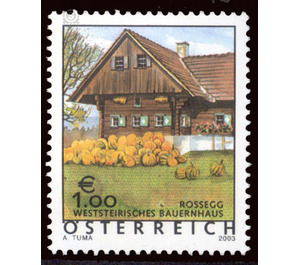Holiday Country Austria - Austria / II. Republic of Austria 2003 - 100 Euro Cent
Theme: Architecture
| Country | Austria / II. Republic of Austria |
| Issue Date | 2003 |
| Face Value | 100.00 |
| Printing Type | Photogravure |
| Stamp Type | Definitive |
| Item Type | Stamp |
| Chronological Issue Number | 1760 |
| Chronological Chapter | OOS-OE2 |
| SID | 574455 |
| In 74 Wishlists | |
From the original peasant building culture very little remains except in open-air museums. The renewal took place in three stages: first in the High Middle Ages, then at the end of the 18th and beginning of the 19th century, at the same time as the Industrial Revolution, when it was transferred from fallow to fertilizer and from sickle to scythe, and through new root crops The stable feeding could improve the productivity and thus the often miserable living conditions. This has led to the enlargement and change of the farms. The third, largest stage of construction measures was around 1955, where modern agriculture with tractors and machinery and cultivation on a scientific basis space.From wooden buildings were stone, the living rooms were lighter, airier, spacious, healthier, the windows larger, from smoking rooms was first the Rauchkuchl, then the smoke-free kitchen with Sparherd, the thatched roofs were to tile roofs, straw- and clay-packed walls were replaced by baked bricks. The soft skin, which had been stained with lime, was temporarily removed from the cement plaster. In western Styria there are block buildings and brick houses. The houses are often extended by an additional room at right angles to the main wing and covered by steep roofs with sweeping gables, under which there is a "Gangl".


